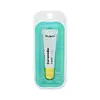What's inside
What's inside
 Key Ingredients
Key Ingredients

 Benefits
Benefits

 Concerns
Concerns

 Ingredients Side-by-side
Ingredients Side-by-side

Phytosteryl/Isostearyl/Cetyl/Stearyl/Behenyl Dimer Dilinoleate
Skin ConditioningPentaerythrityl Tetraethylhexanoate
EmollientDiisostearyl Malate
EmollientHydrogenated Polyisobutene
EmollientEthylhexyl Stearate
EmollientCeresin
Emulsion StabilisingMethyl Hydrogenated Rosinate
PerfumingTribehenin
EmollientSilica Dimethyl Silylate
EmollientPolymethylsilsesquioxane
Vp/Hexadecene Copolymer
Ethylene/Propylene/Styrene Copolymer
Butylene/Ethylene/Styrene Copolymer
Ceramide NP
Skin ConditioningCitrus Aurantium Bergamia Fruit Oil
MaskingDehydroacetic Acid
PreservativeHippophae Rhamnoides Oil
EmollientPelargonium Graveolens Flower Oil
MaskingSalvia Officinalis Oil
MaskingPogostemon Cablin Leaf Oil
MaskingWater
Skin ConditioningDipropylene Glycol
HumectantHydrogenated Lecithin
EmulsifyingCetyl-Pg Hydroxyethyl Palmitamide
Skin ConditioningPropanediol
SolventGlyceryl Stearate
EmollientSodium Hyaluronate Crosspolymer
HumectantCeramide Ns
Skin ConditioningHydrolyzed Glycosaminoglycans
HumectantGlycerin
HumectantSodium Hyaluronate
HumectantCeramide AP
Skin ConditioningCeramide As
Skin ConditioningBenzyl Glycol
SolventHydrolyzed Hyaluronic Acid
HumectantCholesterol
EmollientEthylhexylglycerin
Skin ConditioningCeramide EOP
Skin ConditioningHyaluronic Acid
HumectantRaspberry Ketone
MaskingPhytosteryl/Isostearyl/Cetyl/Stearyl/Behenyl Dimer Dilinoleate, Pentaerythrityl Tetraethylhexanoate, Diisostearyl Malate, Hydrogenated Polyisobutene, Ethylhexyl Stearate, Ceresin, Methyl Hydrogenated Rosinate, Tribehenin, Silica Dimethyl Silylate, Polymethylsilsesquioxane, Vp/Hexadecene Copolymer, Ethylene/Propylene/Styrene Copolymer, Butylene/Ethylene/Styrene Copolymer, Ceramide NP, Citrus Aurantium Bergamia Fruit Oil, Dehydroacetic Acid, Hippophae Rhamnoides Oil, Pelargonium Graveolens Flower Oil, Salvia Officinalis Oil, Pogostemon Cablin Leaf Oil, Water, Dipropylene Glycol, Hydrogenated Lecithin, Cetyl-Pg Hydroxyethyl Palmitamide, Propanediol, Glyceryl Stearate, Sodium Hyaluronate Crosspolymer, Ceramide Ns, Hydrolyzed Glycosaminoglycans, Glycerin, Sodium Hyaluronate, Ceramide AP, Ceramide As, Benzyl Glycol, Hydrolyzed Hyaluronic Acid, Cholesterol, Ethylhexylglycerin, Ceramide EOP, Hyaluronic Acid, Raspberry Ketone
Octyldodecanol
EmollientC18-38 Alkyl Hydroxystearoyl Stearate
EmollientRicinus Communis Seed Oil
MaskingCaprylic/Capric Triglyceride
MaskingGlycerin
HumectantPanthenol
Skin ConditioningBis-Diglyceryl Polyacyladipate-2
EmollientWater
Skin ConditioningPolyglyceryl-3 Diisostearate
EmulsifyingButyrospermum Parkii Butter
Skin ConditioningHydrogenated Castor Oil
EmollientTocopherol
AntioxidantTocopheryl Acetate
AntioxidantSodium Ascorbyl Phosphate
AntioxidantBisabolol
MaskingBeeswax
Emulsion StabilisingC20-40 Alkyl Stearate
Skin ConditioningMagnesium Stearate
Cosmetic ColorantMagnesium Sulfate
Octyldodecanol, C18-38 Alkyl Hydroxystearoyl Stearate, Ricinus Communis Seed Oil, Caprylic/Capric Triglyceride, Glycerin, Panthenol, Bis-Diglyceryl Polyacyladipate-2, Water, Polyglyceryl-3 Diisostearate, Butyrospermum Parkii Butter, Hydrogenated Castor Oil, Tocopherol, Tocopheryl Acetate, Sodium Ascorbyl Phosphate, Bisabolol, Beeswax, C20-40 Alkyl Stearate, Magnesium Stearate, Magnesium Sulfate
 Reviews
Reviews

Ingredients Explained
These ingredients are found in both products.
Ingredients higher up in an ingredient list are typically present in a larger amount.
Glycerin is already naturally found in your skin. It helps moisturize and protect your skin.
A study from 2016 found glycerin to be more effective as a humectant than AHAs and hyaluronic acid.
As a humectant, it helps the skin stay hydrated by pulling moisture to your skin. The low molecular weight of glycerin allows it to pull moisture into the deeper layers of your skin.
Hydrated skin improves your skin barrier; Your skin barrier helps protect against irritants and bacteria.
Glycerin has also been found to have antimicrobial and antiviral properties. Due to these properties, glycerin is often used in wound and burn treatments.
In cosmetics, glycerin is usually derived from plants such as soybean or palm. However, it can also be sourced from animals, such as tallow or animal fat.
This ingredient is organic, colorless, odorless, and non-toxic.
Glycerin is the name for this ingredient in American English. British English uses Glycerol/Glycerine.
Learn more about GlycerinWater. It's the most common cosmetic ingredient of all. You'll usually see it at the top of ingredient lists, meaning that it makes up the largest part of the product.
So why is it so popular? Water most often acts as a solvent - this means that it helps dissolve other ingredients into the formulation.
You'll also recognize water as that liquid we all need to stay alive. If you see this, drink a glass of water. Stay hydrated!
Learn more about Water